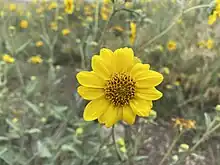| Helianthus pumilus | |
|---|---|
 | |
| Scientific classification | |
| Kingdom: | Plantae |
| Clade: | Tracheophytes |
| Clade: | Angiosperms |
| Clade: | Eudicots |
| Clade: | Asterids |
| Order: | Asterales |
| Family: | Asteraceae |
| Genus: | Helianthus |
| Species: | H. pumilus |
| Binomial name | |
| Helianthus pumilus Nutt. 1841 | |
Helianthus pumilus is a North American species of sunflower known by the common name little sunflower[1] or bush sunflower.[2] It is found in the western United States, primarily the Rocky Mountain region of Montana, Wyoming, and Colorado, with a few isolated populations in Utah and Idaho.[3]
Helianthus pumilus grows on dry rocky soil in the mountains and nearby plains. It is a perennial herb up to 100 cm (40 inches) tall. One plant usually produces 1-6 flower heads, each containing 8-13 yellow ray florets surrounding 30 or more yellow or brown disc florets.[1][4]
References
- 1 2 Flora of North America, Helianthus pumilus Nuttall, 1841. Little sunflower
- ↑ United States Department of the Interior, National Park Service, Rocky Mountain National Park, Bush Sunflower helianthus pumilus
- ↑ Biota of North America Program 2014 county distribution map
- ↑ Nuttall, Thomas 1841. Transactions of the American Philosophical Society, new series 7: 366–367
External links
This article is issued from Wikipedia. The text is licensed under Creative Commons - Attribution - Sharealike. Additional terms may apply for the media files.
